Chico Buarque e a ótica do movimento
Mots-clés :
Chico Buarque, ambivalence, complexification, neutralization, semioticsRésumé
The present work supports that the precision and mastery with which Chico Buarque translates the very essence of the Brazilian culture relies upon the fact he incorporates movement on the core of his work. To support this view, we show how the author constructs ambivalent worlds encircled by no sharp boundaries, making their existence dependent of a continuous pendulum movement between their building poles. From the analysis of the song “Homenagem ao malandro "and the novel Estorvo, we try to convey how Chico Buarque extrapolates the common sense order by exploring different ways to construct ambivalent worlds based upon opposite backbone logical structures: one builtfrom the co-presence and the other from the co-absence of extreme poles##plugins.themes.default.displayStats.downloads##
##plugins.themes.default.displayStats.noStats##
Téléchargements
Publiée
2003-12-08
Numéro
Rubrique
Ensaios
Licence
O envio de artigos por seus autores pressupõe a cessão dos direitos de publicação à revista Teresa.
Comment citer
Mancini, R. (2003). Chico Buarque e a ótica do movimento. Teresa, 4-5, 144-165. https://journals.usp.br/teresa/article/view/116374



